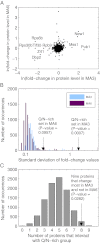Interactions of subunit CCT3 in the yeast chaperonin CCT/TRiC with Q/N-rich proteins revealed by high-throughput microscopy analysis
- PMID: 23112166
- PMCID: PMC3503220
- DOI: 10.1073/pnas.1209277109
Interactions of subunit CCT3 in the yeast chaperonin CCT/TRiC with Q/N-rich proteins revealed by high-throughput microscopy analysis
Abstract
The eukaryotic chaperonin containing t-complex polypeptide 1 (CCT/TRiC) is an ATP-fueled machine that assists protein folding. It consists of two back-to-back stacked rings formed by eight different subunits that are arranged in a fixed permutation. The different subunits of CCT are believed to possess unique substrate binding specificities that are still mostly unknown. Here, we used high-throughput microscopy analysis of yeast cells to determine changes in protein levels and localization as a result of a Glu to Asp mutation in the ATP binding site of subunits 3 (CCT3) or 6 (CCT6). The mutation in subunit CCT3 was found to induce cytoplasmic foci termed P-bodies where mRNAs, which are not translated, accumulate and can be degraded. Analysis of the changes in protein levels and structural modeling indicate that P-body formation in cells with the mutation in CCT3 is linked to the specific interaction of this subunit with Gln/Asn-rich segments that are enriched in many P-body proteins. An in vitro gel-shift analysis was used to show that the mutation in subunit CCT3 interferes with the ability of CCT to bind a Gln/Asn-rich protein aggregate. More generally, the strategy used in this work can be used to unravel the substrate specificities of other chaperone systems.
Conflict of interest statement
The authors declare no conflict of interest.
Figures







Similar articles
-
Sequential allosteric mechanism of ATP hydrolysis by the CCT/TRiC chaperone is revealed through Arrhenius analysis.Proc Natl Acad Sci U S A. 2017 May 16;114(20):5189-5194. doi: 10.1073/pnas.1617746114. Epub 2017 May 1. Proc Natl Acad Sci U S A. 2017. PMID: 28461478 Free PMC article.
-
Staggered ATP binding mechanism of eukaryotic chaperonin TRiC (CCT) revealed through high-resolution cryo-EM.Nat Struct Mol Biol. 2016 Dec;23(12):1083-1091. doi: 10.1038/nsmb.3309. Epub 2016 Oct 24. Nat Struct Mol Biol. 2016. PMID: 27775711
-
The structural basis of substrate recognition by the eukaryotic chaperonin TRiC/CCT.Cell. 2014 Nov 20;159(5):1042-1055. doi: 10.1016/j.cell.2014.10.042. Cell. 2014. PMID: 25416944 Free PMC article.
-
TRiC/CCT Chaperonin: Structure and Function.Subcell Biochem. 2019;93:625-654. doi: 10.1007/978-3-030-28151-9_19. Subcell Biochem. 2019. PMID: 31939165 Review.
-
The structural basis of eukaryotic chaperonin TRiC/CCT: Action and folding.Mol Cells. 2024 Mar;47(3):100012. doi: 10.1016/j.mocell.2024.100012. Epub 2024 Jan 26. Mol Cells. 2024. PMID: 38280673 Free PMC article. Review.
Cited by
-
Advances in the study of CCT3 in malignant tumors: A review.Medicine (Baltimore). 2025 Feb 7;104(6):e41069. doi: 10.1097/MD.0000000000041069. Medicine (Baltimore). 2025. PMID: 39928781 Free PMC article. Review.
-
Formation, function, and pathology of RNP granules.Cell. 2023 Oct 26;186(22):4737-4756. doi: 10.1016/j.cell.2023.09.006. Cell. 2023. PMID: 37890457 Free PMC article. Review.
-
Identification of candidate B-lymphoma genes by cross-species gene expression profiling.PLoS One. 2013 Oct 9;8(10):e76889. doi: 10.1371/journal.pone.0076889. eCollection 2013. PLoS One. 2013. PMID: 24130802 Free PMC article.
-
The CCT chaperonin and actin modulate the ER and RNA-binding protein condensation during oogenesis and maintain translational repression of maternal mRNA and oocyte quality.Mol Biol Cell. 2024 Oct 1;35(10):ar131. doi: 10.1091/mbc.E24-05-0216. Epub 2024 Aug 21. Mol Biol Cell. 2024. PMID: 39167497 Free PMC article.
-
RNAi Screen Identifies Novel Regulators of RNP Granules in the Caenorhabditis elegans Germ Line.G3 (Bethesda). 2016 Aug 9;6(8):2643-54. doi: 10.1534/g3.116.031559. G3 (Bethesda). 2016. PMID: 27317775 Free PMC article.
References
-
- Horwich AL, Fenton WA, Chapman E, Farr GW. Two families of chaperonin: physiology and mechanism. Annu Rev Cell Dev Biol. 2007;23:115–145. - PubMed
-
- Yébenes H, Mesa P, Muñoz IG, Montoya G, Valpuesta JM. Chaperonins: two rings for folding. Trends Biochem Sci. 2011;36(8):424–432. - PubMed
-
- Azia A, Unger R, Horovitz A. What distinguishes GroEL substrates from other Escherichia coli proteins? FEBS J. 2012;279(4):543–550. - PubMed
-
- Gao Y, Thomas JO, Chow RL, Lee GH, Cowan NJ. A cytoplasmic chaperonin that catalyzes β-actin folding. Cell. 1992;69(6):1043–1050. - PubMed
-
- Yaffe MB, et al. TCP1 complex is a molecular chaperone in tubulin biogenesis. Nature. 1992;358(6383):245–248. - PubMed
Publication types
MeSH terms
Substances
LinkOut - more resources
Full Text Sources
Molecular Biology Databases
Miscellaneous

